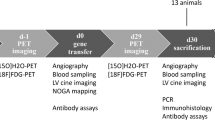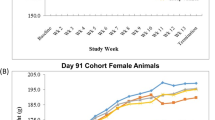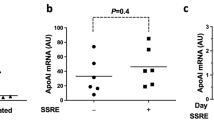Abstract
Catalytically active thrombin, acting locally, is thought to mediate neointima formation after arterial injury. We constructed an adenovirus vector, AdHV–1.2, containing a complementary DNA for the thrombin inhibitor hirudin. AdHV–1.2 directed the synthesis and secretion of biologically active hirudin from vascular cells in vitro. In vivo gene transfer of hirudin into smooth muscle cells of injured rat carotid arteries resulted in peak secretion of at least 34 ± 23 pg hirudin per vessel per 24 hours, and resulted in a significant (P < 0.05) 35% reduction in neointima formation. Systemic partial thromboplastin times were not affected by local hirudin expression. These results support the hypothesis that local thrombin activity contributes to neointima formation after arterial injury and suggest that local delivery of a highly specific antithrombin may constitute an effective intervention for arterial proliferative disease.
This is a preview of subscription content, access via your institution
Access options
Subscribe to this journal
Receive 12 print issues and online access
$209.00 per year
only $17.42 per issue
Buy this article
- Purchase on Springer Link
- Instant access to full article PDF
Prices may be subject to local taxes which are calculated during checkout
Similar content being viewed by others
References
Fuster, V., Badimon, L., Badimon, J.J. & Chesebro, J.H. The pathogenesis of coronary artery disease and the acute coronary syndromes (second of two parts). N. Engl. J. Med. 326, 310–318 (1992).
Blombäck, B. Studies on the action of thrombic enzymes on bovine fibrinogen as measured by N-terminal analysis. Arkiv. Kemi. 12, 321–335 (1958).
Davey, M.G. & Lüscher, E.F. Actions of thrombin and other coagulant and pro-teolytic enzymes on blood platelets. Nature 216, 857–858 (1967).
McNamara, C.A. et al. Thrombin stimulates proliferation of cultured rat aortic smooth muscle Cells by a proteolytically activated receptor. J. Clin. Invest. 91, 94–98 (1993).
Markwardt, F. Hirudin as an inhibitor of thrombin. Methods Enzymol. 19, 924–932 (1970).
Just, M., Tripier, D. & Seiffge, D. Antithrombotic effects of recombinant hirudin in different animal models. Haemostasis 21 (Suppl. 1), 80–87 (1991).
Sarembock, I.J. et al. Effectiveness of recombinant desulphatohirudin in reducing restenosis after balloon angioplasty of atherosclerotic femoral arteries in rabbits. Circulation 84, 232–243 (1991).
Topol, E.J. et al. Recombinant hirudin for unstable angina pectoris: A multicenter, randomized angiographic trial. Circulation 89, 1557–1566 (1994).
Serruys, P.W. et al. A comparison of hirudin with heparin in the prevention of restenosis after coronary angioplasty. N. Engl. J. Med. 333, 757–763 (1995).
van den Bos, A.A. et al. Safety and efficacy of recombinant hirudin (CGP 39 393) versus heparin in patients with stable angina undergoing coronary angioplasty. Circulation 88, 2058–2066 (1993).
The Global Use of Strategies to Open Occluded Coronary Arteries (GUSTO) Ha Investigators. Randomized trial of intravenous heparin versus recombinant hirudin for acute coronary syndromes. Circulation 90, 1631–1637 (1994).
Wallace, A., Dennis, S., Hofsteenge, J. & Stone, S.R. Contribution of the N-terminal region of hirudin to its interaction with thrombin. Biochemistry 28, 10079–10084 (1989).
Schulick, A.H., Dong, G., Newman, K.D., Virmani, R. & Dichek, D.A. Endothelium-specific in vivo gene transfer. Circ. Res. 77, 475–485 (1995).
Schulick, A.H., Newman, K.D., Virmani, R. & Dichek, D.A. In vivo gene transfer into injured carotid arteries. Optimization and evaluation of acute toxicity. Circulation 91, 2407–2414 (1995).
Hatton, M.W.C. & Ross-Ouellet, B. Radiolabeled r-hirudin as a measure of thrombin activity at, or within, the rabbit aorta wall in vitro and in vivo. Thromb. Haemost. 71, 499–506 (1994).
Strauss, B.H., van der Giessen, W.J., & Verdouw, P.D., Hirudin and restenosis [Letter to the Editor]. Circulation 85, 1952–1953 (1992).
Benezra, M., Vlodavsky, I., Ishai-Michaeli, R., Neufeld, G. & Bar-Shavit, R. Thrombin-induced release of active basic fibroblast growth factor-heparan sulfate complexes from subendothelial extra cellular matrix. Blood 81, 3324–3331 (1993).
Okazaki, H., Majesky, M.W., Marker, L.A. & Schwartz, S.M. Regulation of platelet-derived growth factor ligand and receptor gene expression by a-thrombin in vascular smooth muscle Cells. Circ. Res. 71, 1285–1293 (1992).
Nelken, N.A. et al. Thrombin receptor expression in normal and atherosclerotic human arteries. J. Clin. Invest. 90, 1614–1621 (1992).
Ohno, T. et al. Gene therapy for vascular smooth muscle Cell proliferation after arterial injury. Science 265, 781–784 (1994).
Guzman, R.J. et al. In vivo suppression of injury-induced vascular smooth muscle cell accumulation using adenovirus-mediated transfer of the herpes simplex virus thymidine kinasegene. Proc. Natl. Acad. Sci. USA 91, 10732–10736 (1994).
Chang, M.W. et al. Cytostatic gene therapy for vascular proliferative disorders with a constitutively active form of the retinoblastoma gene product. Science 267, 518–522 (1995).
von der Leyen, H.E. et al. Gene therapy inhibiting neointimal vascular lesion: In vivo transfer of endothelial cell nitric oxide synthase gene. Proc. Natl. Acad. Sci. USA 92, 1137–1141 (1995).
Indolfi, C. et al. Inhibition of Cellular ras prevents smooth muscle cell proliferation after vascular injury in vivo. Nature Med. 1, 541–545 (1995).
The Multicenter European Research Trial with Cilazapril after Angioplasty to Prevent Transluminal Coronary Obstruction and Restenosis (MERCATOR) Study Group. Does the new angiotensin converting enzyme inhibitor cilaza-pril prevent restenosis after percutaneous transluminal coronary angioplasty? Results of the MERCATOR study: A multicenter, randomized, double-blind placebo-controlled trial. Circulation 86, 100–110 (1992).
Yang, Y., Li, Q., Ertl, H.C.J. & Wilson, J.M. Cellular and humoral immune responses to viral antigens create barriers to lung-directed gene therapy with recombinant adenoviruses. J. Virol. 69, 2004–2015 (1995).
Newman, K.D. et al. Adenovirus-mediated gene transfer into normal rabbit arteries results in prolonged vascular cell activation, inflammation, and neointimal hyperplasia. J. Clin. Invest. 96, 2955–2965 (1995).
Clowes, A.W. & Karnovsky, M.J. Suppression by heparin of smooth muscle cell proliferation in injured arteries. Nature 265, 625–626 (1977).
Guyton, J.R., Rosenberg, R.D., Clowes, A.W. & Karnovsky, M.J. Inhibition of rat arterial smooth muscle Cell proliferation by heparin. In vivo studies with anticoagulant and nonanticoagulant heparin. Circ. Res. 46, 625–634 (1980).
Fortkamp, E., Rieger, M., Heisterberg-Moutses, G., Schweitzer, S. & Sommer, R. Cloning and expression in Escherichia coli of a synthetic DNA for hirudin, the blood coagulation inhibitor in the leech. DNA 5, 511–517 (1986).
Dillon, P.J. & Rosen, C.A. A rapid method for the construction of synthetic genes using the polymerase chain reaction. BioTechniques 9, 298–300 (1990).
Lee, S.W., Trapnell, B.C., Rade, J.J., Virmani, R. & Dichek, D.A. In vivo adenoviral vector-mediated gene transfer into balloon-injured rat carotid arteries. Circ. Res. 73, 797–807 (1993).
Graham, F.L. & Prevec, L. Manipulation of adenovirus vectors. Methods Mol. Biol. 7, 109–128 (1991).
Spannagl, M., Bichler, H., Lill, H. & Schramm, W. A fast photometric assay for the determination of hirudin. Haemostasis 21 (Suppl. 1), 36–40 (1991).
Walsmann, P. Isolation and characterization of hirudin from Hirudo medicinalis. Semin. Thromb. Hemost. 17, 83–87 (1991).
Johnson, P.H. et al. Structure-function and refolding studies of the thrombin-specific inhibitor hirudin. Haemostasis 21 (Suppl. 1), 41–48 (1991).
Daniel, W.W. Biostatistics: A Foundation for Analysis in the Health Sciences, 5th edn. (Wiley, New York, 1991).
Eccleston, E. Normal haematological values in rats, mice and marmosets. in Comparative Clinical Haematology (eds. Archer, R.K. & Jeffcott, L.B.), 611–619 (Blackwell Scientific, Oxford, 1977).
Author information
Authors and Affiliations
Rights and permissions
About this article
Cite this article
Rade, J., Schulick, A., Virmani, R. et al. Local adenoviral–mediated expression of recombinant hirudin reduces neointima formation after arterial injury. Nat Med 2, 293–298 (1996). https://doi.org/10.1038/nm0396-293
Received:
Accepted:
Issue Date:
DOI: https://doi.org/10.1038/nm0396-293
This article is cited by
-
Macromolecular Transport in the Arterial Wall: Alternative Models for Estimating Barriers
Annals of Biomedical Engineering (2005)
-
Gene therapy for cerebral vascular disease: update 2003
British Journal of Pharmacology (2003)
-
In vivo suppression of restenosis in balloon-injured rat carotid artery by adenovirus-mediated gene transfer of the cell surface-directed plasmin inhibitor ATF.BPTI
Gene Therapy (2001)
-
Clinical applications of vascular gene therapy
Current Cardiology Reports (2001)



